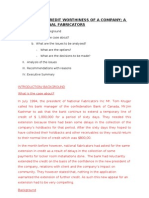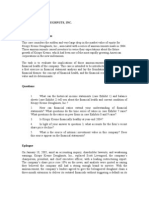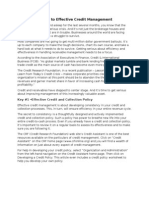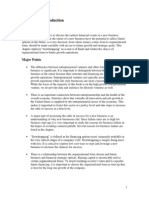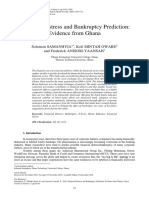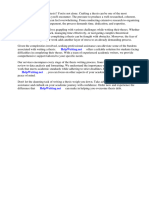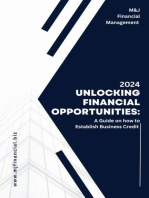Setting Up Accounts Receivable Policies For Business in Canada
Setting Up Accounts Receivable Policies For Business in Canada
Uploaded by
asdefenceCopyright:
Available Formats
Setting Up Accounts Receivable Policies For Business in Canada
Setting Up Accounts Receivable Policies For Business in Canada
Uploaded by
asdefenceOriginal Description:
Original Title
Copyright
Available Formats
Share this document
Did you find this document useful?
Is this content inappropriate?
Copyright:
Available Formats
Setting Up Accounts Receivable Policies For Business in Canada
Setting Up Accounts Receivable Policies For Business in Canada
Uploaded by
asdefenceCopyright:
Available Formats
Setting up Accounts Receivable Policies for Business in Canada Factoring of A/R ABC 4/15/2013
Factoring of A/R
The account receivable financing is becoming popular in Canada as an alternative financing or tagged as the working capital solutions for the business, the Canadians entrepreneurs and the business managements, this is an asset- financing arrangement, used by the organization in the financial collection, either on any of the one receivable, or mostly adopted as an ongoing debtors basis of the organization. The account receivable financing can be synonymous as factoringa day to day description of the accounts receivable finance. It allows the owners to receive cash on an immediate basis, on the billing of cash upon the receivables. Some portion of the invoice is always held- back as a tradition, adding up the lender's fee for the finance. The organization receives an amount equivalent to a reduced value of the receivables pledge/ mortgage. The age of the receivables decides the life of the pledge, hence the newer is the receivables the more company expects and vice versa. In general the invoices of more than 90 days are not saleable and thus no cash flow can be obtained from them. Factoring or accounts receivable financing helps the organization, to release the investment that has been devoted in the accounts receivables. The recent investigation in US has shown that the factoring of the working capital is one of the most feasible business in Canada, and the growth rate of this business is even growing rapidly, the factoring of the working capital is also known as the
Factoring of A/R
accounts receivable financing facility in the US. When getting business credit is complex for the organization, the organizations owners search for a number of tactics to finance their cooperations properly.
Sales are the revenue generated by the cooperation, from its products and services Marketing shows the advertisement and the promotional policies made by the firms Finance shows the initial investment or the capital invested by the owner in his business. The business follows up operational services to continue its productivity and management However, African-American business entrepreneur suggest that capital
requirements may not be exclusively completed by the banking system in America. as per the investigation made by various scholars showed that the banking
Factoring of A/R
catastrophe, capital deficit in addition to authoritarian complexity have became radical grounds of reductions in banks giving credits to the organizations and firms, in countries like, Japan, Korea the Scandinavian countries, the USA,
Canada and the others. Additionally the bank's critical situation is followed by recessions, depression, resulting in lesser economic growth and higher interest rates. A study by a few Chinese investigators focused on the liquidity restraints in the development of the trade and commerce in the economy, these investigations note the liquid finance available to the organizations, and note down the liquidity constraints in the business, it results in the emphasis on the availability of exterior finance as compared to the internal financing in the organization. The important factors like, the transaction costs, agency problems and asymmetric information have created such constraints for small businesses in China. Focusing on these investigations, Wang in 2004 emphasized that the small in addition to the average business play an essential role in economys development specifically China. The growing economic reform of development in the business enterprises of China. The dominating back draws being faced by the Chineses business are the lacking behind in the banking system, inadequate financial structure and lack of a guarantee system. A same investigation results could be seen in Thailand. Contemporary investigations by various researchers showed that the Economic Crisis in 1997 in the South East Asian nations created a highly confused in
Factoring of A/R
addition to a contemporary economic environment; hence the business organizations in Thailand faced complexity in gaining the internal and external finance for their business. An international investigation stated that the formally external financing by the banks is divided into four major categories: 1-the start-up and registration, 2- the survival cost 3- surviving in the economy, 4- establishment of the organization, another investigation states that in the first stage almost a 91 percent firms of West Germany had availed bank exterior fianc, a 56 percent of the Canadian organization, 21percent of the Japanese organization, 32 percent of The Netherlands. In the second stage, the survival cost almost a 21 percent of the Canada organizations, 32 percent of the Japans organizations, 87 percent of the West Germany had bank loans, in the third stage of surviving in the economy 87 percent in West Germany had bank loans, 73 percent in Canada organizations had bank loans, 61 percent in Japan the organizations had bank loans and 60 percent in The Netherlands organizations had bank loans in addition at the last stage establishment of the organization almost 84 percent of the organizations had bank loans in West Germany , 77 percent of the organizations had bank loans in Canada, 84 percent of the organizations had bank loans in Japan and 71 percent of the organizations had bank loans in The Netherlands. Another investigation showed, on the survival stage of business 86 percent of the organizations had bank loans in West Germany, 67 percent of the organizations had bank loans in Canada,
Factoring of A/R
81 percent of the organizations had bank loans in Japan and 67 percent of the organizations had bank loans in The Netherlands. A survey showed, the Small enterprises are the pillar of the economic growth and expansions; it is to note that such organizations have out shuns their larger contributions in innovations, inventions in the business, their creativity, the foremost dominating factors in term of the modern natured business are revolving around 11 basic factors faced in general, by the American- Anglo co-operation, those financial variables affecting the organizations are: 1- Being incapability to get external financing; 2- Inadequate capital; 3- Important working expenses; 4- Poor wealth management; 5- Large losses due to offense; 6- Meeting the wages management; 7- Incapability to get hold of trade credit; 8- Inadequate warnings; 9- Aptitude to meet monetary pressure; 10- The health insurance expenses 11- The cost of workers compensation.
Factoring of A/R
In fact, the incapability of the organizations to get hold of the firms internal as well as the external financing has been continuously highlighted by the intellectual as well as the scholars. Statistical investigations make it clear that out of the total short term loans the Blacks are approving loans 62 percent of the time, Hispanics are approved loans 87 percent of the time followed by 90 percent of Whites and 96 percent for Asians. Another investigation showed that the business structures in India are more probable to have debt burdens as contrast with the huge competitors in the market. These financial circumstances took place because the business in India may not be able to compete with their counterparts. In 2009 it was observed the small-scale manufacturing sector of the economy and the monetary issued faced by them in India as well as in Sri Lanka. He examined that the small- scale and the private sector is facing difficulties for the reason that the trend of provisions is quite low in these areas, much of the emphasize is on self- raising of finance rather to borrow from the financial banks on interests in Sri- Lanka.
Factoring of A/R
Account Receivable Policies in Canada The business, sole proprietors, partnerships in US is five times even more expanded that of a corporation, however the revenue generated by the cooperations is eight times higher than that of the sole owners and partners, e.g. Coca- Cola, Exxon Mobile, GM, have more expanded operations as well as generate more revenues. The financial data of the organization are helpful for decision- making, setting up the organizations policies and reviews, as well as the organization profit earnings standings, the financial data are helpful for two
Factoring of A/R
broader categories: 1- the internal users, 2- the external users of the data. The Internal category may include answering the questions like: a- If we have sufficient cash to pay dividend to our shareholders? B-what price of an Apples IPod will maximize the companys net income? C- Can we afford to give the general Motor employees a pay raise this year, d- which of the Pepsi product line is most profitable, should any of the product line be eliminated. The internal illustrations convey the information in a pastoral farm, and aid in visualizing in addition to applying the ideas studied in the organization. The external information regarding to the organization .I.e. a- is General Electric earns a satisfactory income? B- how does Disney compare in size and profitability with Time Warner, c- will United Airlines be able to pay its debts as they come due?, the external information is highly payable for the stakeholders intending to invest in the organization, for the taxing authorities, for the angel investors, etc.
The Alternative Facility Accounts receivable financing sometimes transfers the default risk of the bad debts of the financing companies, in such a type of financing the firm or the organization which is factored to the organization, accepts the risk of credit connected with the absolute collection of the account receivables, How does a lender accepts this? obviously the portfolio is insured by the lender, and normally the cost of insurance
10
Factoring of A/R
is one to two percent above the pledge at least. The economy of Canada is occupied by numerous organizations that will factor the accounts without a doubt. Such organizations are the category of large US firms or are normally subsidized by largest US firms or otherwise these are small firms owned by the residents of Canada, in the latter, normally the sole entities invest a huge amount of capital. When any Canadian organization commences the accounts receivable factoring, it is essential for the organization to comprehend knowledge about the profile, the goodwill, and the potential of the firm to sustain in the market regarding the factoring. Until business confer about some special offers and facilities the factoring shall have a good amount of the client contact, which will confirm the customer invoices, make sure to the client of the invoice acceptance, as well as the offered goods and services to the clientage and most probably follows up the clients for direct payments.
Basic Cash Flow of Financing When the organization generates the positive outcomes, till it started a hundred years ago in the US plus some additional places in the world, it started in Europe and Asia some hundred years ago, recently in the North American markets, numerous product alike factoring is being widely offered. Facilitating the offer to
11
Factoring of A/R
an adequate amount of cash flows the business grows well and attains its goals, the major accomplishments of factoring are: The business owners are when assuring of cash flows they can focus on the running of the business, thus the organization would point out a time safety in the factoring firm is collecting firms account receivables. Many Canadian firms, do not like the direct contact with their customers, and thus factors are widely spread in the Canadian economy. The Canadian environment has been slow to catch on the factoring. The firms in Canada are now free to sell a receivable at 2-3% range on a monthly basis The transfer of the risk of accounts receivable is one foremost merit of factoring. The immediate cash flows in the business are important for the regular running of the business offered from factoring. Now the balance sheet of the firm is more liquid .I.e. showing on the asset side cash in hand rather than accounts receivable. A trusted, creditable business factor aids in affirmative solutions for the business If factoring is done properly, with the right partner, it becomes a solid path for growth and success. Facilitates organization to stand up on the own footings. Makes a strategy to be ahead of its competitors
12
Factoring of A/R
In a large number of organizations in Canada, the real discount rate (customers mix it up with the interest rate) lies in the 1.5 - 2% range. That stands on a yield of accounts receivable at a 30 day time, which in numerous points of thought, become impractical in the modern day B2B (business to business) surroundings. This is a fact, among the key points in the financing of the receivables in Canada. The greater parts (not all) factor their investment, accounts receivables by the firms in Canada, through their temperament become the assortment dept. when they insert themselves into your business process. If you were to maintain be in command of over your own financial records as well as assortment you may listened in a hostile way for the accumulating of your financial statements, you in effect have consulted one of the most violent Accounts Receivable pricing of Canada. Moreover, when you factor in all the churches of a bank-line of credit counting the standing on by-fees, the vacant staff charges, miscellaneous bank charges etc you will find that your total reimbursements to finance in a bank competence is almost certainly a bit advanced than you may have considered. Also, the bank- lines are under particular credit restrictions, along with the one of many key benefits of factoring in Canada is that your facility grows in security device step as your company grows
13
Factoring of A/R
Key ABL concept vs. traditional Line of Credit In addition to the usual due diligence or field exam carried out prior to obtaining credit approval, an ABL lender will require a review of the creditworthiness of the borrowers clients as well as an appraisal of inventories, and any other assets, to be included as collateral. A professional appraiser may be mandated, at the borrowers expense, to evaluate the quality of the inventories and prepare a Net Orderly Liquidation Value or NOLV. This is essentially an estimate of the net realizable value of the assets should they have to be liquidated to repay the debt.
14
Factoring of A/R
The lender/borrower relationship and the funding mechanics are directly related to the value of the collateral. This value, called the borrowing base, is generally calculated on a monthly basis as follows: Predefined percentage (70% to 85%) of good and current trade receivables subject to maximum exposure by account and disqualifications for overdue accounts. Plus, a pre-defined percentage of the NOLV of good and current inventories (And/ or other assets), Less priority claims (i.e. Current payroll, government remittances, etc.) that may rank ahead of the lender in the event of liquidation. A borrower may draw funds to a maximum of the value of the current borrowing base or the value of the approved facility if the borrowing base exceeds the facility. The difference between the amount actually borrowed and the borrowing base is the spare borrowing capacity or excess availability. The size of the excess availability can be used to trigger different loan provisions. Lenders will usually agree to lessen controls and reporting requirements so long as a minimum excess availability has been maintained since the greater the spread between the collateral value and the actual amount borrowed the lesser the risk to the lender. ABL facilities can thus be structured with springing covenants and
15
Factoring of A/R
other conditions which are triggered if the minimum availability falls below a certain minimum. In other words as the borrowing approaches the maximum
Asset based Valuation One of the additional pioneering financial produce gaining popularity in the Canadian market is Asset Based Lending or ABL financing. Asset Based Lending had been used and adopted in the US market for a number of years, as well as adopted as a loan of last resort for the complex credit state of affairs, ABL investment has gone the ordinary norms and values and today it is an attractive substitute for the traditional loan products. What is Asset Based Lending? An asset based loan is frequently offered as a protected rotating procession of credit backed By the accounts receivables and inventories as collateral; in a number of situations, or the other assets for example equipment and/ real estate may be included. The loan advanced is determined by a formula-based computation ranging from 70 to 85% of receivables adding up a percentage of the estimated liquidation value of inventories or other collaterals. ABL financing lends itself particularly well to
16
Factoring of A/R
asset rich cooperations balanced for growth, or face with seasonal or cyclical businesses. It often provides more funding than a conventional facility. Advantages of ABL Financing Traditional facilities are fundamentally productivity or cash flow based, that is, credits comprehended on the basis of the borrowers ability to uphold a strong balance sheet and produce enough cash to examine the debt and maintain the business. Since the traditional money lenders guarantee the balance sheet and cash flow to make certain debt service, they normally oblige operating and financial limitations as well as well hold the borrowers respect financial covenant such as: A smallest working capital ratio, A lesser tangible net worth of the assets, A greater debt to equity ratio, The lowest interest coverage ratio, A lesser Debt service coverage ratio.
17
Factoring of A/R
Unfortunately, seasonal or cyclical businesses, or businesses that unexpectedly suffer from a temporary event (i.e. Delayed shipments, inventory buildups or economic downturn) can suddenly find such covenant ratios to be very restrictive. At worst, the borrower may needlessly find himself in default, which can trigger a series of restrictions with both the loan facility and possibly with other business agreements containing no default clauses. An ABL Facility, on the other hand, provides credit based on the estimated liquidation value of the secured collateral. Although Asset Based Lenders still look to ensure that a borrower can service the debt, their primary recourse lies in the value of the collateral irrespective of seasonal, cyclical or economic fluctuations and their impact on cash flows. As a result, ABL lenders typically require fewer and less restrictive covenants; in some
18
Factoring of A/R
instances covenants may not be required at all. ABL facilities can often provide greater liquidity and are more flexible and patient financing than traditional loan products. For example, a company building up a large inventory to drive ingrown may fail to convince a conventional lender to provide as much funding as an ABL lender may be capable of delivering. Although ABL loans were originally more expensive than conventional facilities, the field has become more competitive and ABL lenders offer increasingly attractive rates as they move into the main stream market. Nonetheless, since ABL lenders require close monitoring of collateral values on a monthly or even weekly basis, such facilities can be more costly to manage for some borrowers. Loans and the Cash Flow Financing Loans are the debts payable in a certain period of time, with a specific reimbursement. A numerous kinds of loans and debts are offered by the banks: Open- ended Loans- are the type of loans that the borrower can take over and over. Credit cards and the open lines of credit are the examples of such loan type, within a certain limit the customer has the option to make usage. Each time he uses his account, the limit of credit he has decreased, and as he makes payment the credit limit increases, allowing the customer to make use of credit over and over
19
Factoring of A/R
Closed- ended loans- in these types of loans, customers can borrow only once, and the balance of the loan goes down as the loan is used, and if you need money you need to apply for another loan Secured Loans- these loans rely on the security provided by the customer, the asset need to be appraised before you borrow a loan. Unsecured Loans- these loans dont have collectable, and rely on the credit history of the customer, and the income of the customer, If you default on an unsecured loan, the lender has to exhaust collection options including debt collectors and lawsuit to recover the loan. Conventional Loans- the mortgage loans are called the conventional loans, Conventional loans are those that arent insured by a government agency like the Federal Housing Administration (FHA), Rural Housing Service (RHS), or the Veterans Administration (VA). Loans to Avoid- certain loans should be avoided. Payday loans are short-term loans borrowed using your next paycheck as a guarantee for the loan Advance-fee loans arent really loans at all. In fact, theyre simply scams to get money from you. Advance-fee loans use different tactics to convince borrowers to send money to obtain the loan.
20
Factoring of A/R
Although a loan does not start out as earnings to the borrower, it becomes earnings to the borrower if the borrower is set free of indebtedness. Thus, if a debt is released, then the borrower essentially has received income equal to the amount of the indebtedness. The Internal Revenue Code lists Income from Discharge of Indebtedness in Section 61 (a) (12) as a source of gross income. Example: X owes Y $50,000. If Y discharges the indebtedness, then X no longer owes Y $50,000. For purposes of calculating income, this should be treated the same way as if Y gave X $50,000 Since the cooperations professionals and the management is more concerned as how the company shall meet its present and the future obligation and the arising liabilities in regards to the important factors that affect the performance of the company.thus we can use the understanding of equity financing and the valuation of net income to analyze the factors that affect the companys cash procedings
21
Factoring of A/R
References Platters, P. (2000). THE EVALUATION OF CONTRACTORS BASED ON FINANCIAL DATA USlNG DATA ENVELOPMENT ANALYSIS . A thesis submitted in conformity with the requirements for the degree of Master of Applied Science Graduate Department of Civil Engineering University of Toronto. W. Mulford, C. and E. Comiske, E. (2013). Creative Cash Flow Reporting: Uncovering Sustainable Financial Performance. Abuzayed, B. (2012). Working capital management and firms performance in emerging markets: the case of Jordan. International Journal of Managerial Finance Vol. 8 No. 2, 2012 pp. 155-179. C. Groth, J. and S. Byers, S. (1996). Creating value: economics and accounting perspectives for managers.Management Decision 34/10 [1996] 5664.
22
Factoring of A/R
D. Kimmel, , P. et al. eds. (2013). Financial Accounting: Tools for Business Decision Making. Dobbins, R. and O. Pettman, B. (1997). Self-development: the nine basic skills for business success. Ferris, T. and D. Hattiches, P. (2011). Untitled. H. Hamilton, R. et al. (2005). Timeless advice: Daniel Defoe and small business management. Management Decision Vol. 43 No. 10, 2005 pp. 1304-1316. Habib, A. and Islam, A. (2007). Determinants and consequences of non-audit service fees Preliminary evidence from Bangladesh. Managerial Auditing Journal Vol. 22 No. 5, 2007 pp. 446-469 q Emerald Group Publishing Limited 0268-6902. Hofmann, E. (2009). Inventory financing in supply chains A logistics service provider-approach. International Journal of Physical Distribution & Logistics Management Vol. 39 No. 9, 2009 pp. 716-740. Humayun Kabir, M. and Sharma, D. (2011). accruals quality in
Bangladesh. Managerial Auditing Journal Vol. 26 No. 2, 2011 pp. 161-181. Jouber, H. and Fakhfakh, H. (2013). Earnings management and board oversight: an international comparison.
23
Factoring of A/R
K. Mitchell, R. (1997). Oral history and expert scripts: demystifying the entrepreneurial experience. Inte Jnl of Entrepreneurial Behaviour & Research, Vol. 3 No. 2, 1997, pp. 122-139.. Kierulff, H. and L. Petersen, H. (2009). Finance is everything: advice from turnaround managers. VOL. 30 NO. 6 2009, pp. 44-51, Q Emerald Group Publishing Limited, ISSN 0275-6668. L. Crawford, R. and R. Weirich, T. (2011). Fraud guidance for corporate counsel reviewing financial statements and reports. Journal of Financial Crime Vol. 18 No. 4, 2011 pp. 347-360. Lonergan, W. (2010). Impairment a commercial perspective. Managerial Finance Vol. 36 No. 9, 2010 pp. 812-826 #Emerald Group Publishing Limited 0307-4358. Shahrokhi, M. (2008). E-finance: status, innovations, resources and future challenges. Managerial Finance Vol. 34 No. 6, 2008 pp. 365-398. Unknown. (2008). "Audit of Accounts Receivable WESTERN ECONOMIC DIVERSIFICATION CANADA Audit and Evaluation Branch", paper presented at untitled conference.
24
Factoring of A/R
Unknown. eds. (2013). The Impact of the Global Crisis on SME and Entrepreneurship Financing and Policy Responses. ORGANISATION FOR ECONOMIC CO-OPERATION AND DEVELOPMENT. Prokop, S. Untitled, Prokop, S. (n.d.). Untitled. ACCOUNTS RECEIVABLE FINANCING AND FACTORING FACILITIES HELP CANADIAN BUSINESSES GROW!, [web log] Retrieved from:
http://www.evancarmichael.com/Business-Financing.
You might also like
- Strategic Analysis of TescoDocument21 pagesStrategic Analysis of Tescosadiachaudhary80% (5)
- National Fabricators 1Document8 pagesNational Fabricators 1Sam Addi33% (3)
- Case 06 NotesDocument4 pagesCase 06 NotesUmair Mushtaq SyedNo ratings yet
- Case Studies in Working Capital Management and ShortDocument13 pagesCase Studies in Working Capital Management and ShortNguyễn Thế Long100% (1)
- Think Globally Act LocallyDocument5 pagesThink Globally Act LocallyasdefenceNo ratings yet
- Think Globally Act LocallyDocument5 pagesThink Globally Act LocallyasdefenceNo ratings yet
- The Eighth Commandment: Go With The (Cash) FlowDocument7 pagesThe Eighth Commandment: Go With The (Cash) FlowDavid 'Valiant' OnyangoNo ratings yet
- How To Grow A Business - Funding StrategiesDocument8 pagesHow To Grow A Business - Funding StrategiesSangram PandaNo ratings yet
- Thesis On Sources of FinanceDocument4 pagesThesis On Sources of Financeleslylockwoodpasadena100% (3)
- At Capital OneDocument36 pagesAt Capital OnesumeetpatnaikNo ratings yet
- Thesis On Debt FinancingDocument8 pagesThesis On Debt Financingheidimaestassaltlakecity100% (2)
- Credit Rating Agencies DissertationDocument7 pagesCredit Rating Agencies Dissertationdipsekator1983100% (1)
- 5 Keys To Effective Credit ManagementDocument5 pages5 Keys To Effective Credit Managementloral.narayanan3944100% (4)
- ch13 SM RankinDocument10 pagesch13 SM Rankinhasan jabrNo ratings yet
- RRLDocument3 pagesRRLJessamen BernalesNo ratings yet
- The Handbook of Financing Growth: Strategies, Capital Structure, and M&A TransactionsFrom EverandThe Handbook of Financing Growth: Strategies, Capital Structure, and M&A TransactionsNo ratings yet
- Financing A New Venture Trough and Initial Public Offering (IPO)Document32 pagesFinancing A New Venture Trough and Initial Public Offering (IPO)Manthan LalanNo ratings yet
- Chapter 3 USERS OF ACCOUNTING INFORMATIONDocument27 pagesChapter 3 USERS OF ACCOUNTING INFORMATIONmarkalvinlagunero1991No ratings yet
- SWOTDocument4 pagesSWOTKatlene HortilanoNo ratings yet
- GJBP Vol 2 No 1 2018-pgs-124-133Document10 pagesGJBP Vol 2 No 1 2018-pgs-124-133siddhi66421No ratings yet
- Group 1 ThesisDocument9 pagesGroup 1 ThesisFallcia B. AranconNo ratings yet
- Term Paper of Financial ManagementDocument6 pagesTerm Paper of Financial Managementafmzmxkayjyoso100% (2)
- Summary of Case DiscussionDocument2 pagesSummary of Case DiscussionNur 'AtiqahNo ratings yet
- Finance Dissertation SampleDocument8 pagesFinance Dissertation SampleSomeoneToWriteMyPaperForMeEvansville100% (1)
- Cash Flow DissertationDocument6 pagesCash Flow DissertationHelpWritingACollegePaperCanada100% (2)
- ENTER (Assignment)Document39 pagesENTER (Assignment)Shyam ChoudharyNo ratings yet
- Chapter 1Document5 pagesChapter 1Said FikriNo ratings yet
- Activity 1: JP MORGAN CHASE: Financial Partnerships in ActionDocument2 pagesActivity 1: JP MORGAN CHASE: Financial Partnerships in ActionMaximillianous GideonNo ratings yet
- Budgetary Control Katherine Jackson - FeedbackDocument20 pagesBudgetary Control Katherine Jackson - FeedbackkatieNo ratings yet
- Teaching Suggestions Revised 22222Document54 pagesTeaching Suggestions Revised 22222Chaudhry KhurramNo ratings yet
- Finance and The Multinational FirmDocument13 pagesFinance and The Multinational FirmFatin Afifa100% (1)
- Contemporary Issues in Finance - International Aspects of Corporate Finance - Jerralyn AlvaDocument5 pagesContemporary Issues in Finance - International Aspects of Corporate Finance - Jerralyn AlvaJERRALYN ALVANo ratings yet
- Cash Mana - Bajaj Finance - 24 - PlegaDocument66 pagesCash Mana - Bajaj Finance - 24 - PlegaMohmmed KhayyumNo ratings yet
- 3 Users of Accounting InformationDocument23 pages3 Users of Accounting Informationapi-267023512100% (1)
- Thesis Financial Statement AnalysisDocument5 pagesThesis Financial Statement Analysisheatheredwardsmobile100% (1)
- Market Research On Cause of Client DropoutDocument25 pagesMarket Research On Cause of Client Dropouthailu letaNo ratings yet
- Financial Distress and Bankruptcy Prediction: Evidence From GhanaDocument14 pagesFinancial Distress and Bankruptcy Prediction: Evidence From Ghanafisayobabs11No ratings yet
- Financial Institutions and Markets AM ST Hwteh7Document10 pagesFinancial Institutions and Markets AM ST Hwteh7Alimo shaikhNo ratings yet
- Dissertation On Credit ManagementDocument6 pagesDissertation On Credit ManagementPaperWritingServicesBestUK100% (1)
- Nova Southeastern University H. Wayne Huizenga School of Business & EntrepreneurshipDocument6 pagesNova Southeastern University H. Wayne Huizenga School of Business & EntrepreneurshipJoel De JesusNo ratings yet
- Microfinance Note 1Document12 pagesMicrofinance Note 1Vandi GbetuwaNo ratings yet
- Unit 8 FinanceDocument4 pagesUnit 8 FinanceNgọc Nguyễn NhưNo ratings yet
- Financial Analysis Dissertation PDFDocument8 pagesFinancial Analysis Dissertation PDFProfessionalCollegePaperWritersUK100% (1)
- Fundamentals of Business: Reference ManualDocument53 pagesFundamentals of Business: Reference ManualprakruthiNo ratings yet
- Chapter 12-14 A FixedDocument162 pagesChapter 12-14 A FixedDaniel Luke Higgins0% (2)
- Dissertation On Debt ManagementDocument5 pagesDissertation On Debt ManagementHelpWithAPaperNewOrleans100% (1)
- EssayDocument7 pagesEssayGiana ObejasNo ratings yet
- Debt Financing, Survival, and Growth of Start-Up FirmsDocument17 pagesDebt Financing, Survival, and Growth of Start-Up FirmsHanane KadiNo ratings yet
- Private Debt in 2015Document8 pagesPrivate Debt in 2015ed_nycNo ratings yet
- PHD Thesis Financial Statement AnalysisDocument8 pagesPHD Thesis Financial Statement Analysisveronicapadillaalbuquerque100% (2)
- Unit 3 A Final DraftDocument12 pagesUnit 3 A Final Draftnoora alsuwaidiNo ratings yet
- The Future of Private Equity - MCK 2009Document6 pagesThe Future of Private Equity - MCK 2009apritul3539No ratings yet
- 3 Users of Accounting InformationDocument29 pages3 Users of Accounting InformationAdrianChrisArciagaArevaloNo ratings yet
- Policy Research Working Paper Bank Credit Allocation in Latin America and The CaribbeanDocument48 pagesPolicy Research Working Paper Bank Credit Allocation in Latin America and The CaribbeanBrian HughesNo ratings yet
- Thesis DebtDocument6 pagesThesis Debtafcnoxdhv100% (2)
- 1cm8numop 690958Document49 pages1cm8numop 690958vmadasamy80No ratings yet
- Dissertation Report of FinanceDocument5 pagesDissertation Report of FinanceCustomWrittenPapersClarksville100% (1)
- Financial Distress: Vishesh Kumar 13917703519 Bba LLB, 2-MDocument14 pagesFinancial Distress: Vishesh Kumar 13917703519 Bba LLB, 2-MVishesh KumarNo ratings yet
- Financial Term PaperDocument4 pagesFinancial Term Paperafdtslawm100% (1)
- Harvard Venture CapitalDocument48 pagesHarvard Venture Capitalmjose.apaza.serranoNo ratings yet
- Yo BuddyDocument14 pagesYo BuddyVishesh KumarNo ratings yet
- The Nonprofit Funding Playbook: Building Credit and Securing Financing: Business credit, #1From EverandThe Nonprofit Funding Playbook: Building Credit and Securing Financing: Business credit, #1No ratings yet
- Unlocking Financial Opportunities: A Comprehensive Guide on How to Establish Business CreditFrom EverandUnlocking Financial Opportunities: A Comprehensive Guide on How to Establish Business CreditNo ratings yet
- AccountingDocument14 pagesAccountingasdefence50% (2)
- 2.3.2.2 Inaccurate Time EstimateDocument1 page2.3.2.2 Inaccurate Time EstimateasdefenceNo ratings yet
- 03 Emergency Response & RecoveryDocument104 pages03 Emergency Response & RecoveryasdefenceNo ratings yet
- 101 Cw1 d1 - Revision 1Document16 pages101 Cw1 d1 - Revision 1asdefenceNo ratings yet
- The Effect of The Media: ObjectiveDocument8 pagesThe Effect of The Media: ObjectiveasdefenceNo ratings yet
- 03 Emergency Response & RecoveryDocument104 pages03 Emergency Response & RecoveryasdefenceNo ratings yet
- DemingDocument12 pagesDemingasdefenceNo ratings yet
- Name Asma Khalil: Address - House 2 Street 1 Phase 3 Tajbagh Lahore Mobile - 03028474692 03364596975 E-MailDocument2 pagesName Asma Khalil: Address - House 2 Street 1 Phase 3 Tajbagh Lahore Mobile - 03028474692 03364596975 E-MailasdefenceNo ratings yet
- Please, Some Vocabulary No Need To Change Like (Purification, SynthesisDocument6 pagesPlease, Some Vocabulary No Need To Change Like (Purification, SynthesisasdefenceNo ratings yet
- 28 Disability Support AppendixdDocument20 pages28 Disability Support AppendixdasdefenceNo ratings yet
- Meghan Mcgowan Professor Gervais Case #3 4/2/12: Starbucks CorporationDocument13 pagesMeghan Mcgowan Professor Gervais Case #3 4/2/12: Starbucks Corporationasdefence50% (2)
- Bellows Deming 21stDocument12 pagesBellows Deming 21stasdefenceNo ratings yet
- Meghan Mcgowan Professor Gervais Case #3 4/2/12: Starbucks CorporationDocument13 pagesMeghan Mcgowan Professor Gervais Case #3 4/2/12: Starbucks Corporationasdefence50% (2)
- A Review of The Strategic Situation of KepakDocument5 pagesA Review of The Strategic Situation of KepakasdefenceNo ratings yet
- Antonio Damasio: A M P MDocument6 pagesAntonio Damasio: A M P MasdefenceNo ratings yet
- A Guild To Asset-Based Lending PDFDocument5 pagesA Guild To Asset-Based Lending PDFLoh Wai SengNo ratings yet
- Credit Risk Rating ConsiderationsDocument3 pagesCredit Risk Rating ConsiderationsBarno NicholusNo ratings yet
- ABL Asset-Based Lending Guide April 2015Document20 pagesABL Asset-Based Lending Guide April 2015Venp PeNo ratings yet
- Mayer Brown Net Asset Value Credit FacilitiesDocument5 pagesMayer Brown Net Asset Value Credit FacilitiesJose GoncalvesNo ratings yet
- 2 - RX Guide - Q&ADocument40 pages2 - RX Guide - Q&ALorenzo MorosiniNo ratings yet

